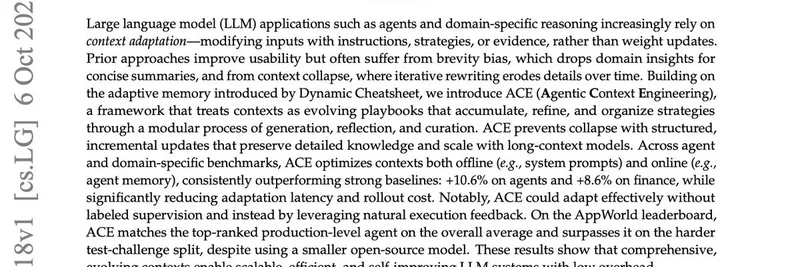In the fast-paced world of AI and blockchain, staying ahead means embracing innovations that make tech smarter and more efficient. A recent thread on X by AI expert Robert Youssef (@rryssf_) has the community buzzing about a groundbreaking Stanford paper that's set to change how we think about training large language models (LLMs). Titled "Agentic Context Engineering: Evolving Contexts for Self-Improving Language Models," this research introduces ACE—a method that lets AI improve itself without the hassle and expense of traditional fine-tuning.
What is Agentic Context Engineering?
At its core, ACE shifts the focus from tweaking a model's internal weights to dynamically evolving its context—the information and instructions it uses to make decisions. Instead of retraining the entire model, which can be resource-intensive, ACE allows the AI to refine its own prompts through a loop of generation, reflection, and curation. This creates a "living notebook" where the model learns from successes and failures, building a denser, more effective context over time.
Youssef breaks it down simply: the system splits into three roles—the Generator that performs tasks, the Reflector that critiques outcomes, and the Curator that updates the context with targeted changes. This avoids "context collapse," a common issue where rewriting prompts leads to lost details and degraded performance.
Why This Matters for Meme Tokens and Blockchain
For meme token enthusiasts and blockchain practitioners, ACE opens up exciting possibilities. Imagine AI agents that trade meme coins, generate viral content, or analyze market hype—all while self-improving without needing constant developer intervention. In the volatile world of crypto, where trends shift in hours, having low-cost, low-latency AI that adapts on the fly could be a game-changer. No more hefty fine-tuning bills; just evolving contexts that make your bots smarter with each interaction.
The paper's results back this up: ACE delivered a 10.6% boost on agent tasks like AppWorld, 8.6% on financial reasoning, and matched top models like GPT-4 while using smaller, open-source alternatives. Plus, it cuts latency by 86.9% and costs by up to 80%—music to the ears of bootstrapped meme token projects.
Overcoming Traditional Limitations
Previous methods often fell short because they overwrote contexts, leading to accuracy drops. ACE sidesteps this by making incremental "delta updates," preserving knowledge while adding new insights. As Youssef notes, this makes AI systems interpretable and reversible—you can track exactly how the model learns, step by step.
In contrast to fine-tuning, which alters the model's core, ACE updates understanding through context. It's cheaper, faster, and aligns perfectly with decentralized blockchain ecosystems where efficiency and adaptability are key.
The Future of AI in Crypto
Looking ahead, ACE hints at a shift where prompts become the new "weights" of AI. For meme tokens, this could mean AI-driven communities that evolve their own narratives, or trading algorithms that remember past pumps and dumps to predict the next big thing. As Youssef puts it, we're entering an era of "living prompts" that remember and adapt across sessions.
If you're diving into AI for your next meme token launch or blockchain project, this is tech worth watching. Check out the full paper on arXiv and follow the conversation on X.
Whether you're a developer, trader, or just a meme lover, innovations like ACE are bridging AI and blockchain in ways that could supercharge the next wave of crypto creativity. Stay tuned for more updates on how these advancements play out in the meme token space.



